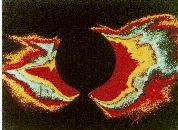The Solar Wind
The Sun makes itself known throughout much of the Solar System by the influence the solar wind of high-speed charged particles constantly blowing off the Sun. The solar wind may be viewed as an extension of the outer atmosphere of the Sun (the corona) into interplanetary space.
Components of the Solar Wind
The solar wind contains roughly equal number of electrons and protons, along with a few heavier ions, and blows continously from the surface of the Sun at an average velocity of about 400 km/second. This is a remarkable velocity: particles in the solar wind from the Sun's surface travel at a speed that would allow them to go from Knoxville to Memphis in less than 2 seconds! This wind leads to a mass loss of more than 1 million tons of material per second, which may seem like a large number, but is insignificant relative to the total mass of the Sun.The Role of the Coronal Magnetic Field
 |
|
Magnetic field lines in the solar corona |
The adjacent image shows an enhanced image of the solar corona. In
this image the magnetic field lines of the corona correspond
approximately to the boundaries between regions of different color (more
info). Notice that in the equatorial regions the field lines traced
by these color boundaries tend to form closed loops, indicating the
trapping of coronal gas.
Influence of the Solar Wind on the Earth
As we have already discussed in the section on the Earth, the solar wind can have a large influence on our planet, particularly in times of the active Sun (near sunspot maximum) when the wind is strong and can contain bursts corresponding to flares and coronal mass ejections from the Sun. The solar wind has a significant influence on our ionosphere, the Earth's magnetic field, on Earth's auroras, and on telecommunication systems. For example, there is reason to believe that a burst of particles from a coronal mass ejection detected 5 days earlier by SOHO may have killed the Telstar 401 communications satellite on January 11, 1997 (News Story).Earth's Ionosphere and the Sun
The level of activity on the Sun can have a large influence on the Earth's ionosphere, as illustrated in the following animations.The adjacent animations simulate the variation by month of the ionosphere for two different years: 1. The year 1990 (upper image), which was a period of high
solar activity with many (150) sunspots. The plots show electron density contours, which are an indication of the amount of ionization in the atmosphere. Yellows and reds indicate larger ionization and blues and greens indicate smaller ionization. Notice the substantial differences in these two animations, with much stronger atmospheric ionization in the upper image (the active Sun of 1990) than the lower image (the quiet Sun of 1996). The adjacent images are based on these electron density contour maps of the ionosphere for months in the year 1957 to the present. Additional animations may be found in this NOAA directory. |
|
The level of solar activity has similar effects on related phenomena such as Earth's auroras.
The "Space Weather" Report
One can monitor solar data for the last 30 days. This data gives information on solar flares, sunspots, X-ray and radio-frequency fluxes. One can even tune into Today's Space Weather, which gives a "weather report" of current and predicted conditions in space with respect to the solar wind, solar activity, X-ray activity, and related phenomena. For example, here is the space weather outlook that was reported on January 27, 1998:| Space Weather Outlook
SOLAR ACTIVITY IS EXPECTED TO REMAIN LOW. REGIONS 8142 AND 8143 COULD PRODUCE ISOLATED C-CLASS FLARES. THERE IS ALSO A SLIGHT CHANCE FOR AN M-CLASS FLARE FROM EITHER REGION. THE GEOMAGNETIC FIELD IS EXPECTED TO BE MOSTLY QUIET THROUGH 28 JANUARY. A DISTURBANCE IS EXPECTED DURING 29 - 30 JANUARY IN RESPONSE TO THE PARTIAL-HALO CME THAT OCCURRED ON 25 JANUARY. UNSETTLED TO MINOR STORM LEVELS ARE EXPECTED DURING THE DISTURBANCE. |
In this report, the region numbers refer to active areas on the Sun, C and M are classifications of solar flares, and CME stands for a coronal mass ejection. As noted above in conjuction with the ill-fated Telstar 401 satellite, "space weather" may have non-trivial practical consequences.